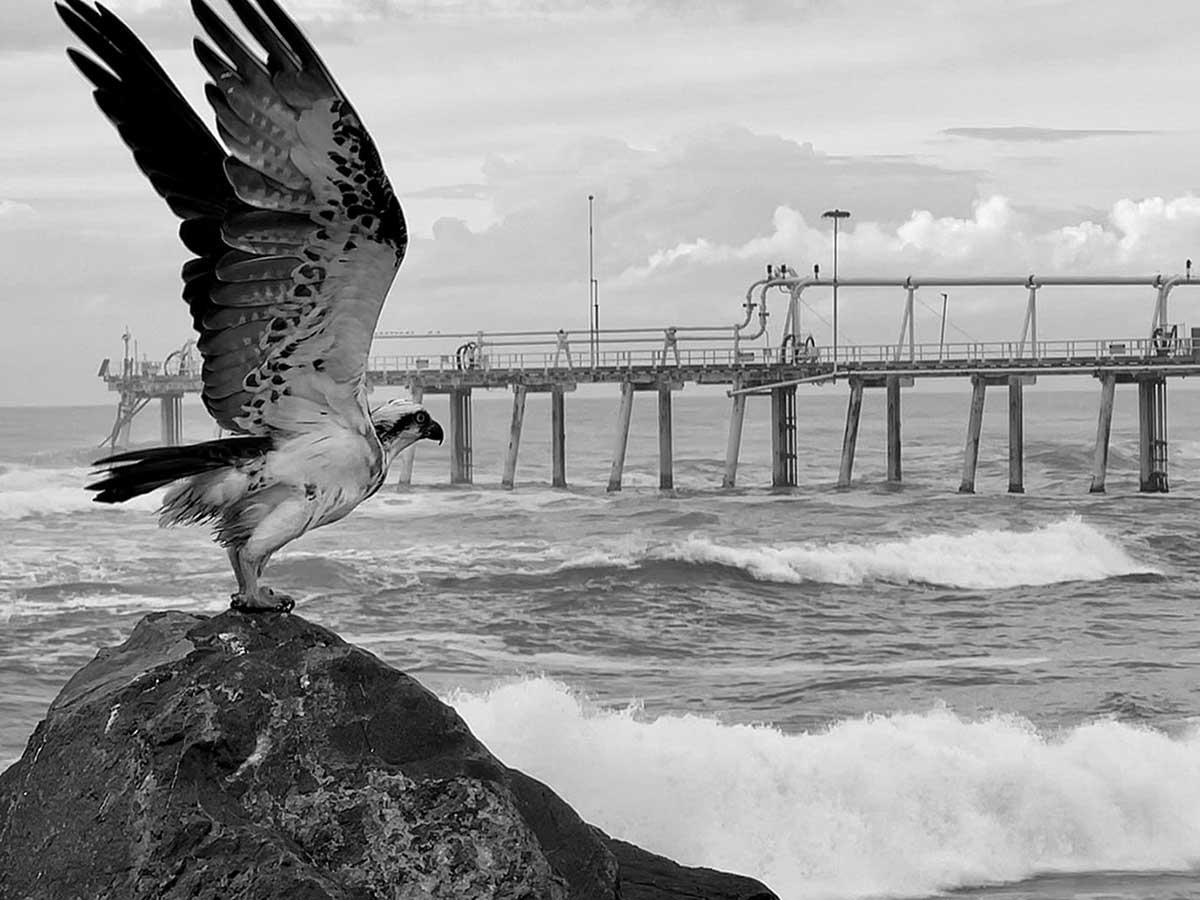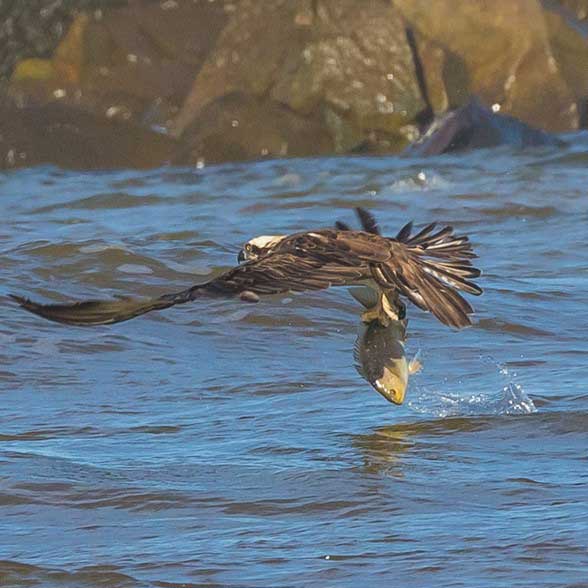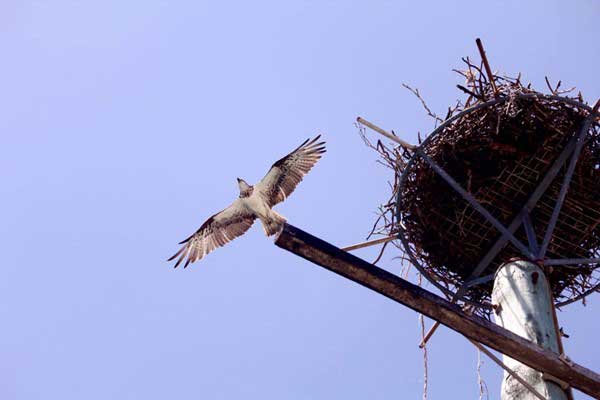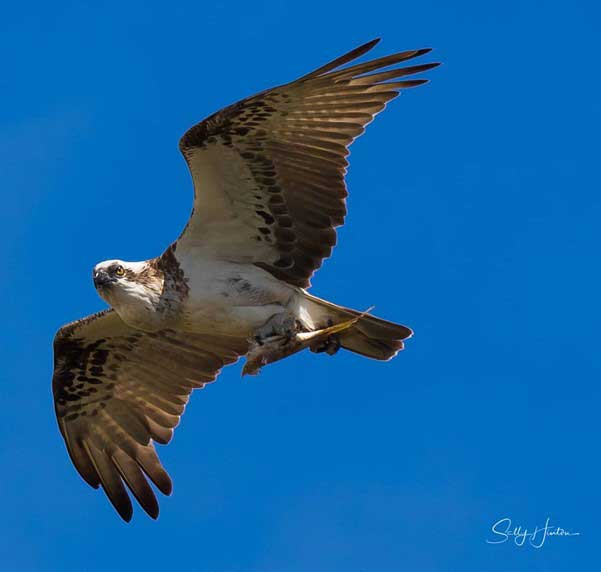Osprey
 An osprey overlooking its artificial nest site on the Tweed Sand Bypass jetty. Photo: Dean Lock
An osprey overlooking its artificial nest site on the Tweed Sand Bypass jetty. Photo: Dean LockAlso known as sea hawks and bihyin, in eastern Bundjalung dialect.
Osprey are listed as vulnerable under the Biodiversity Conservation Act 2016 in NSW.
A targeted strategy for managing this species has been developed within NSW Government's Saving our Species (SoS) threatened species conservation program.
The ospreys of the Tweed are much-admired and cherished by locals and tourists alike. Council is working to ensure they are secure in the wild, their habitat is protected and restored and they remain an iconic member of our community for future generations.
Threats What is being done How can you help Report
View the Digital Osprey Story Map
In Tweed Shire, osprey observations have been recorded from the Tweed Coast to the upper limits of Tweed River Estuary in Murwillumbah.
As of the 2022 breeding season, there were 27 artificial and 2 natural nests in the Tweed Shire, with 20 active breeding sites.
 The great catch! An osprey flying low over the surface of the water with a freshly caught fish in its talons at Hastings Point. Photo: Sally Hinton
The great catch! An osprey flying low over the surface of the water with a freshly caught fish in its talons at Hastings Point. Photo: Sally HintonOsprey are water-dependent raptors (birds of prey) that feed only on fish.
As top order predators, they are integral to biodiversity in estuarine ecosystems and their presence in our waterways can be an indicator of waterway health.
Riparian land within Tweed's estuaries accommodates vital breeding habitat for our vulnerable osprey population. However, the historical removal of established, native riparian vegetation has reduced both suitable nesting sites and habitat connectivity through the landscape.
In the absence of tall, mature trees, the majority of Tweed Shire's vulnerable osprey population now rely on artificial nesting structures during their annual breeding season (March to November).
 An osprey circling high above one of Tweed’s artificial nesting structures
An osprey circling high above one of Tweed’s artificial nesting structuresThe provision of secure, artificial nesting structures for osprey, as well as reinstating connectivity, through riparian restoration and revegetation, are key to Council's holistic approach to improving the health of both individual waterways and the broader catchment.
What threats do ospreys face?
Loss of habitat
Including the disturbance and/or removal of large trees that have been/could be used as nest sites. Due to lack of suitable trees, there is a threat of potential electrocution when osprey are forced to build their nests on top of electricity infrastructure.
Fishing tackle
Improperly discarded fishing line, lures and other tackle pose choking and entanglement hazards to both adults and chicks and can interfere with parental care of chicks. Discarding fish, with attached or ingested fishing tackle, also poses a significant threat to ospreys.
Vehicles
Osprey fledglings are vulnerable to car strikes when nests are in close proximity to busy roads.
UAVs
An unmanned aerial vehicle (UAV), such as a drone or model aeroplane, may be perceived as a predator by an osprey. If a parent bird is preoccupied with defending their nest from a drone, it could result in neglect of vulnerable eggs and chicks, reducing their chance of breeding success. Birds that attack drones could also be injured by moving blades.
Fish stocks
Osprey have a fish-only diet so abundance and diversity of fish species is key to their survival. Any threats to seagrass and mangroves therefore threaten native fish stocks that the osprey and other aquatic animals such as dolphins and dugongs rely on.
What is being done in Tweed Shire to help ospreys?
In Tweed Shire, Council collaborates with a range of stakeholder groups to protect and restore osprey habitat, as well as supporting breeding pairs to secure their population.
Council is committed to:
- Assessment and maintenance of existing artificial nesting structures.
- Provision of new nesting structures, as needed.
- Mapping of nest sites.
- Supporting the Tweed Osprey Group.
- Community engagement and education through social media, traditional media and using innovative tools like the Ospreys of Tweed story map.
- Habitat restoration programs on both private and public riparian land via the River Health Grants program.
 An osprey flying high after a successful fishing expedition. Photo: Sally Hinton
An osprey flying high after a successful fishing expedition. Photo: Sally HintonHow can you help ospreys?
Keep waterways clean
Take rubbish home or put it in a bin.
Fish responsibly
- Dispose of fishing line responsibly
- Don't discard fish with tackle still attached or that has been ingested
- Use environmentally-friendly tackle such as lead-alternative sinkers, biodegradable line, and non-stainless hooks.
Help monitor nests
During breeding season (March to November) Tweed Osprey Group volunteers monitor nesting sites annually throughout the Tweed Shire. This dedicated group is always looking for volunteers. If you can help, email Tweed Osprey Group coordinator, Faye Hill, for more details: fayelillian@hotmail.com
Report injured birds
If you come across an injured osprey please contact Tweed Valley Wildlife Carers on their 24-hour hotline: 02 6672 4789
Report damaged nests
Report damaged nesting poles, perches and/or cradles to Tweed Shire Council: tsc@tweed.nsw.gov.au or 02 6670 2400
Please note: If the nesting pole has electricity wires, Council will convey information to the appropriate energy company regarding their property.
Limit UAV or drone activity
From March to November, especially, it is vital to minimise disturbance to nesting osprey pairs.
Boating
Be mindful when boating in the vicinity of seagrass beds to not disturb or damage them.